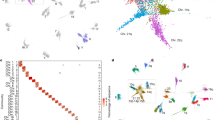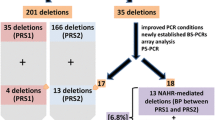Abstract
The molecular organization of HLA-DQ regions derived from DR7, DQw2, and DR4, DQw3 parental haplotypes and DR7, DQw3, a presumed recombinant haplotype, have been studied to define the sequences between DQA1 and DQB1 which may have been involved in this recombinational event. The breakpoint was localized in the intergenic region near the 3′ end of the DQB1 gene by restriction mapping. DNA sequences in the immediate vicinity of the breakpoint in DR7, DQw2 (parental), and DR7, DQw3 (recombinant) haplotypes revealed the presence of (CA)22 repeats, minisatellite-related sequences and GC-rich sequences. The intergenic regions varied considerably depending on the haplotype and contained several additional types of repetitive sequences including Alu and LINE repeats. Some of these sequences are related to sequences previously suggested to be involved in meiotic or somatic recombination. In particular, (CA)n repeats, which can adopt the Z-DNA conformation, have previously been shown to promote recombination in several systems.
Similar content being viewed by others
References
Blanck, G. and Strominger, J. L.: Molecular organization of the DQ subregion (DO-DX-DV-DQ) of the human MHC and its evolutionary implications. J Immunol 141: 1734–1737, 1988
Bodmer, J. G., Marsh, S. G. E., and Albert, E.: Nomenclature for factors of the HLA system, 1989. Immunol Today 11: 3–10, 1990
Boehm, T., Mengle-Gaw, L., Kees, U. R., Spurr, N., Lavenir, I., Forster, A., and Rabbitts, T. H.: Alternating purinepyrimidine tracts may promote chromosomal translocations seen in a variety of human lymphoid tumours. EMBO J 8: 2621–2631, 1989
Canning, S. and Dryja, T. P.: Short, direct repeats at the breakpoints of deletions of the retinoblastoma gene. Proc Natl Acad Sci USA 86: 5044–5048, 1989
Casavant, N. C., Hardies, S. C., Funk, F. D., Comer, M. B., Edgell, M. H., and Hutchinson, C. A.: Extensive movement of LINES ONE sequences in \-globin loci of Mus caroli and Mus domesticus. Mol Cell Biol 8: 4669–4674, 1988
Edelman, W., Kroger, B., Goller, M., and Horak, I.: A recombination hotspot in the LTR of a mouse retrotransposon identified in an in vitro system. Cell 57: 937–946, 1989
Feinberg, A. and Vogelstein, B.: A technique forradiolabeling DNA restriction endonuclease fragments to high specific activity. Anal Biochem 132: 6–13, 1983
Fishel, R. A., Detmer, K., and Rich, A.: Identification of homologous pairing and strand-exchange activity from a human tumor cell line based on Z-DNA affinity chromatography. Proc Natl Acad Sci USA 85: 36–40, 1988
Gregersen, P. K., Kao, H., Nunez-Roldan, A., Katovich-Hurley, C., Karr, R. W., and Silver, J.: Recombination sites in the HLA class II region are haplotype dependent. J Immunol 141: 1365–1368, 1989
Harada, F., Kimura, A., Iwanage, T., Shimozawa, K., Yata, J., and Sasazuki, T.: Gene conversion-like events cause steroid 21-hydroxylase deficiency in congenital adrenal hyperplasia. Proc Natl Acad Sci USA 84: 8091–8094, 1987
Holliday, R.: Untwisting B-Z DNA. Trends Genet 5: 355–359, 1989
Jarman, A. P. and Wells, R. A.: Hypervariable minisatellites: recombinators or innocent bystanders? Trends Genet 5: 367–371, 1989
Katz, A. and Kahana, C.: Rearrangement between ornithine decarboxylase and the switch region of the γ1 immunoglobulin gene in α-difluoromethylornithine resistant mouse myeloma cells. EMBO J 8: 1163–1167, 1989
Kazazian, H. H., Wong, C., Youssoufian, H., Scott, A. F., Phillips, D. G., and Antonarakis, S. E.: Haemophilia A resulting from de novo insertion of L1 sequences represents a novel mechanism for mutation in man. Nature 332: 164–166, 1988
Kobori, J. A., Strauss, E., Minard, K., and Hood, L.: Molecular analysis of the hotspot of recombination in the murine major histocompatibility complex. Science 234: 173–179, 1986
Lerman, M. A., Russel, D. W., Goldstein, J. L., and Brown, M. S.: Exon-Alu recombination deletes 5 kilobases from the low density lipoprotein receptor gene, producing a null phenotype in familial hypercholesterolemia. Proc Natl Acad Sci USA 83: 3679–3683, 1986
MacMurray, A. J., Bell, J. I., Denney, D., Watling, D., Foster, L. S., and McDevitt, H. O.: Molecular mapping class II polymorphisms in the human major histocompatibility complex. J Immunol 139: 574–586, 1987
Morse, B., Rotherg, P. G., South, V. J., Spandorfer, J. M., and Astrin, S. M.: Insertional mutagenesis of the myc locus by a LINE-1ssequence in a human breast carcinoma. Nature 333: 87–90, 1988
Nicholls, R. D., Fischel-Ghodsian, N., and Higgs, D. R.: Recombination at the Humann α-globin gene cluster: Sequence features and topological constraints. Cell 49: 369–378, 1987
Nordheim, A. and Rich, A.: The sequence (dC-dA)n (dG-dT)n forms left-handed Z-DNA in negatively supercoiled plasmids. Proc Natl Acad Sci USA 80: 1821–1825, 1983
Okada, K., Boss, J. M., Prentice, H., Spies, T., Mengler, R., Auffray, C., Lillie, J., Grossberger, D., and Strominger, J. L.: Gene organization of DC and DX subregions of the human major histocompatibility complex. Proc Natl Acad Sci USA 82: 3410–3414, 1985
Satyanarayana, K. and Rao, M. R. S.: Immunochemical detection of Z-DNA in the meiotic chromatin domains undergoing recombination-repair. Exp Cell Res 185: 319–326, 1989
Shiroishi, T., Hanazawa, N., Sagai, T., Ishiura, M., Gojobori, T., Steimetz, M., and Moriwaki, K.: Recombinational hotspot specific to female meiosis in the mouse major histocompatibility complex. Immunogenetics 31: 79–88, 1990
Skowronski, J., Fanning, T. G., and Singer, M. F.: Unit-length line-1 transcripts in human teratocarcinoma cells. Mol Cell Biol 8: 1385–1387, 1988
Song, Q. L., Gregersen, P. K., Karr, R. W., and Silver, J.: Recombination between DQα and DQ\ genes generates human histocompatibility leukocyte antigen class II haplotype diversity. J Immunol 139: 2993–2995, 1987
Steinmetz, M., Stephen, D., and Fischer Lindahl, K.: Gene organization and recombinational hotspots in the murine major histocompatibility complex. Cell 44: 895–904, 1986
Steinmetz, M., Uematsu, Y., and Fischer Lindahl, K.: Hotspots of homologous recombination in mammalian genomes. Trends Genet 3: 7–10, 1987
Sun, L., Paulson, K. E., Shmid, C. W., Kadyk, L., and Leinwand, L.: Non-Alu family interspersed repeats in human DNA and their transcriptional acticity. Nucl Acids Res 12: 2669–2687, 1984
Sun, H., Treco, D., Schultes, N. P., and Szostak, J. W.: Double-strand breaks at an initiation site for meiotic gene conversion. Nature 338: 87–90, 1989
Thomson, M., Abbal, M., Neugebauer, M., and Cambon-Thomson, A.: Recombinations in the HLA system. Tissue Antigens 33: 38–40, 1989
Todd, J. A., Bell, J. I., and McDevitt, H. O.: HLA-DQ\ gene contributes to susceptibility and resistance to insulin-dependent diabetes mellitus. Nature 329: 599–604, 1987
Treco, D. and Arnheim, N.: The evolutionarily conserved repetitive sequence d(TG AG)n promotes reciprocal exchange and generates unusual recombinant tetrads during yeast meiosis. Mol Cell Biol 6: 3934–3947, 1986
Usdin, K. and Furano, V.: Rat L (long interspersed repeated DNA) elements contain guanine-rich homopurine sequences that induce unpairing of contiguous duplex DNA. Proc Natl Acad Sci USA 85: 4416–4420, 1988
Vogelstein, B., Fearon, E. R., Kern, S. E., Hamilton, S. R., Preisinger, A. C., Nakamura, Y., and White, R.: Allelotype of colorectal carcinomas. Science 244: 207–210, 1989
Wahls, W. P. and Moore, P. D.: Homologous recombination enhancement conferred by the Z-DNA Motif d(TG)30 is abrogated by simian virus 40 T antigen binding to adjacent DNA sequences. Mol Cell Bio 10: 794–800, 1990
Wahls, W. P., Wallace, L. J., and Moore, P. D.: The Z-DNA Motif d(TG)30 promotes reception of information during gene conversion events while stimulating homologous recombination in human cells in culture. Mol Cell Bio 10: 785–793, 1990a
Wahls, W. P., Wallace, L. J., and Moore, P. D.: Hypervariable minisatellite DNA is a hotspot for homologous recombination in human cells. Cell 60: 95–103, 1990b
White, J. H., Dimartino, J. F., Anderson, R. W., Lusnak, K., Hilbert, D., and Fogel, S.: A DNA sequence conferring high postmeiotic segregation frequency to heterozygous deletions in Saccharomyces cerevisiae is related to sequences associated with eucaryotic recombination hotspots. Mol Cell Biol 8: 1253–1258, 1988
Author information
Authors and Affiliations
Additional information
Address correspondence and offprint requests to: J. Strominger.
Rights and permissions
About this article
Cite this article
Satyanarayana, K., Strominger, J.L. DNA sequences near a meiotic recombinational breakpoint within the human HLA-DQ region. Immunogenetics 35, 235–240 (1992). https://doi.org/10.1007/BF00166828
Received:
Revised:
Issue Date:
DOI: https://doi.org/10.1007/BF00166828




